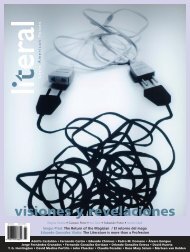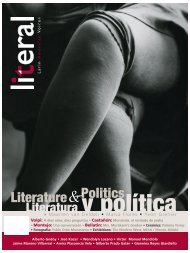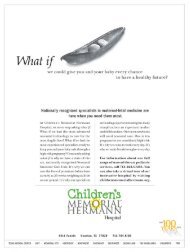Giobany Arévalo > Gabriela Torres Olivares >Anuar Jalife - Literal
Giobany Arévalo > Gabriela Torres Olivares >Anuar Jalife - Literal
Giobany Arévalo > Gabriela Torres Olivares >Anuar Jalife - Literal
You also want an ePaper? Increase the reach of your titles
YUMPU automatically turns print PDFs into web optimized ePapers that Google loves.
ics: Cubism’s analytical and synthetic deconstruction<br />
of representation; Dada’s iconoclastic<br />
use of recycled materials; Neo-Plasticism’s<br />
grid-based metaphysical insights; Surrealism’s<br />
heaping of bizarre intuitions; and Primitive<br />
art, understood as an animistic perception of<br />
a natural world with no tradition.”<br />
In Paris <strong>Torres</strong>-García was fi nally able<br />
dedicate all his energy to painting and writing.<br />
He met key pioneers of the avant-garde<br />
like Piet Mondrian, Jean Arp, and Theo Van<br />
Doesburg, and exhibited his work in important<br />
art galleries. During this period he wrote<br />
introspective texts in search of his own artistic<br />
personality. About originality, he wrote<br />
to himself: “Walk with faith. Because despite<br />
the importance of discovery in art, of<br />
the new theory, of the invention, something<br />
more important makes the work: that which<br />
is really ours and unique to us. That which is<br />
really unprecedented [l’inédit] or nonexistent<br />
before us.”<br />
Some of <strong>Torres</strong>-García’s wood constructions<br />
of masks and fi gures were inspired after<br />
seeing the ancient arts of the Americas in<br />
New York’s Museum of Natural History and in<br />
Paris’ Musée d’Antropologie in 1928. These<br />
primitive-wood fi gures and assamblages challenge<br />
the prevailing aesthetic models of the<br />
1920s that copied industrial production fi nishes.<br />
By favoring a hand-made look and borrowing<br />
the constructive systems in primitive<br />
art, <strong>Torres</strong>-García was going against the trend<br />
in modern art towards a total break with the<br />
past. The pictorial quality of his paintings,<br />
his preference for grays and earth pigments,<br />
which are the trademark of his work, makes<br />
them still unclassifi able. In the context of<br />
The Menil’s superb collections of African and<br />
Oceanic art, <strong>Torres</strong>-García’s objects will show<br />
continuity with mankind’s diverse art works<br />
throughout the ages.<br />
Soon after arriving in South America in<br />
1934, <strong>Torres</strong>-García made a drawing of the<br />
map of the continent up-side down. This radical<br />
image illustrates how important it was for<br />
him to establish his place in the world. His<br />
ambition was to create with the students<br />
of his workshop an independent art movement<br />
in Uruguay which he hoped to export<br />
to the rest of the Americas. By stating that<br />
the South was from now on his North, he<br />
was challenging the supremacy of European<br />
culture at the time in peril due to the second<br />
world war.<br />
The South because it is our North. We<br />
place the map upside down, then we have<br />
the right idea of our hemisphere, not the<br />
way they want it on the other side of the<br />
world. The tip of America points insistently<br />
South, which is our North. The same with<br />
our compass: it leans irremissibly always<br />
South towards our Pole. When ships<br />
leave from here going North, they go<br />
down not up as they used to. Because<br />
North is now under, and Levant is to or<br />
left.<br />
In South America he embarked in a project<br />
to study and validate the cultural heritage<br />
of the Americas. In the exhibition his<br />
last work of wood made in 1944 and titled<br />
Dos formas superpuestas (Two Superimposed Forms), 1931. Private Collection<br />
“Monument,” is included. With roughly cut<br />
blocks of lapacho a local hardwood, he built a<br />
wall like construction inspired by the tectonic<br />
quality of the great stone walls in Cuzco, Peru.<br />
In one block he inscribed the sun, a reference<br />
to Inti the father god in the Inca trilogy, and<br />
a triangle. In other blocks the words abstract<br />
and concrete. This impressive construction unites<br />
two apparently incompatible worlds: the<br />
modern and the ancient, with references to<br />
the great civilizations he most admired; the<br />
classical Greek and the Inca Tiwanaku. In the<br />
large self standing piece, <strong>Torres</strong>-García underscores<br />
what is timeless and common to all<br />
great art: structure, abstraction, and faith in<br />
the religious essence of art.<br />
OTOÑO, 2009 LITERAL. VOCES LATINOAMERICANAS 15






